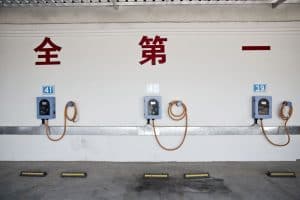
As countries across the world look to grab their share of the electric vehicle supply chain in a rush to go green, energy storage is becoming a key battleground. To add to the pressure, yet another large Chinese battery player is emerging.
China Aviation Lithium Battery Technology Co., or CALB, is looking to go public in Hong Kong for as much as $2 billion. Formed in 2015 under Luoyang Company, a wholly owned unit of the China Airborne Missile Academy — part of state-owned aerospace and defense firm Aviation Industry Corp of China Ltd. — CALB filed offering documents earlier this year. It will raise money just as the race to build manufacturing scale heats up.
CALB makes battery cells, modules and packs for electric vehicles and industrial-scale energy systems — both in high demand as China amps up its storage facilities, with consumer interest in EVs surging and an energy crisis holding back the factory floor of the world.
With a hold on about 7.5% of the Chinese market, CALB is the second-largest maker of ternary batteries — those with high nickel content that boast greater energy density compared to other chemistries — trailing the world’s top powerpack maker China’s Contemporary Amperex Technology Co. It also manufactures the lithium iron phosphate type. By next year, the Jiangsu province-based firm is expected to become one of the largest globally, with 145 gigawatt-hours of production capacity, overtaking Warren Buffett’s Berkshire Hathaway Inc.-backed BYD Co., but still behind CATL, South Korean LG Energy Solution Ltd. and another Chinese battery player, EVE Energy Co., according to Nomura Holdings Inc. analysts.
Right now, every global player is trying to build scale — quickly. Last week alone, firms from Panasonic Holdings Corp. to Toyota Motor Corp. announced billions of dollars of commitments for production facilities. Around the world, industrial policy focused on EVs and batteries is also getting more aggressive, with the introduction of the US Inflation Reduction Act and China’s extension of its EV subsidies that were due to expire this year. Beijing has already handed out about $15 billion in the past decade.
CALB’s capital raise will fund a speedy expansion of its production bases across the country. Since 2019, the company’s spending on construction in progress has more than doubled each year, as has capacity. Manufacturing and operating staff account for almost half of the employees, while research and development technicians make up around 45%. Facilities are expected to range from 10 gigawatt hours to 20-gigawatt hours, with an investment of 5 billion yuan ($724 million) to 10 billion yuan in each. It may not reach CATL’s scale any time soon but it has been expanding at a faster pace. Over the next two years, the company expects its effective production capacity to grow to approximately 55 GWh, compared to CATL’s more than 170 GWh as of 2021. It has set up industrial bases across the country, from Changzhou in the south to Hefei in the east and all the way to Xiamen, Chengdu, Wuhan and Jiangmen.
To circumvent supply chain hiccups, CALB stocked up on raw materials and finished goods. It’s also secured supplies with a stake in metals giant Tianqi Lithium Corp., alongside the likes of LG Chem Ltd., plus a 2.5 billion-yuan contract with Yunnan Energy New Material Co., which makes separators — a key component in powerpacks that’s increasingly scarce. All told, these moves are designed to ensure it can keep expanding at home and, eventually, abroad.
CALB’s battery offensive will help plug the growing gap between global demand and supply. Meanwhile, the rapid emergence of a third and powerful player bodes well for China’s supply chain dominance. CALB also has no shortage of policy-friendly and state-backed shareholders, with a roster of heavy hitters that include a Ministry of Finance-backed fund dedicated to upgrading manufacturing and Three Gorges Capital. Beijing’s support hasn’t hampered its overseas ambitions or raised geopolitical concerns so far: It has already established entities in Germany and the US.
Until recently, Luoyang, which designs and produces batteries for civil and military industrial use, was a controlling shareholder. It became a subsidiary in preparation for going public and to “minimize the impact and potential risk which could be resulted from the military industrial business,” CALB’s offering document noted.
It hasn’t been smooth sailing: Rapid scaling comes with growing pressure. Last year, CATL filed an intellectual property infringement suit against CALB and asked its rival to pay around 190 million yuan for economic losses and expenses incurred, later raising the compensation amount to over 500 million yuan. CALB said the claims are “lacking in merit” and is contesting them.
There are also risks for investors, as the company notes in its prospectus, because it has been added to the US’s list of non-sanctioned Chinese military industrial companies. Still, it has managed to attract support, with backers so far including Xiaomi Corp.’s Lei Jun.
CALB and other Chinese battery manufacturers’ expansion shows how far behind global players remain when it comes to technology and the ability to grow. It also underscores why China’s battery industry is far ahead of the rest.
